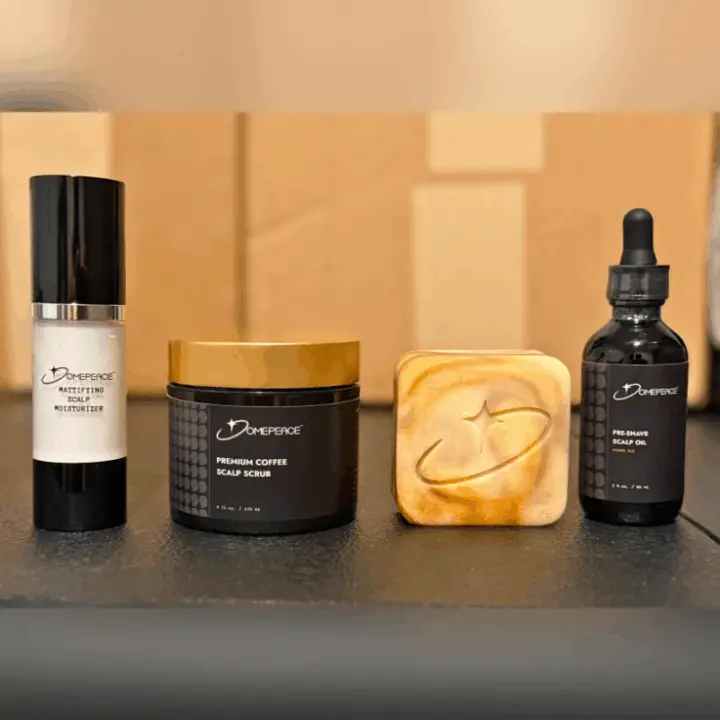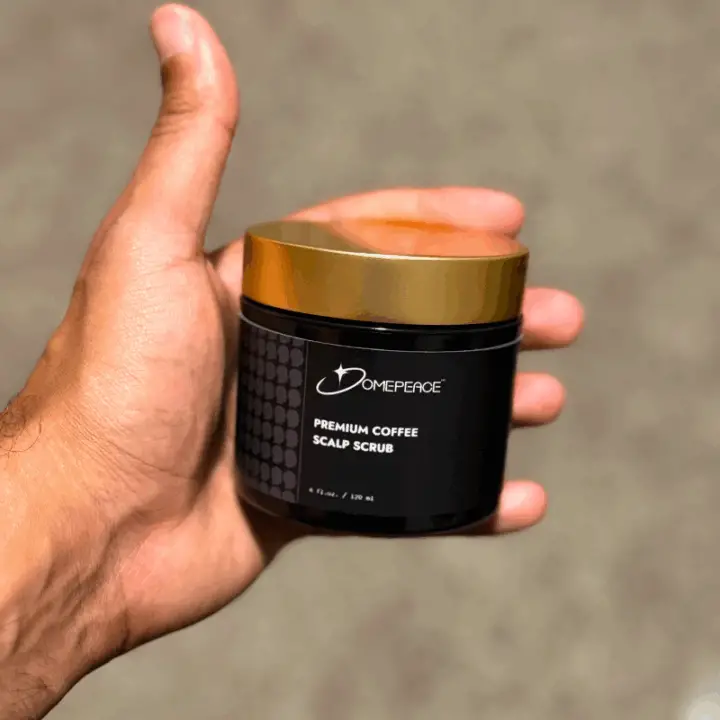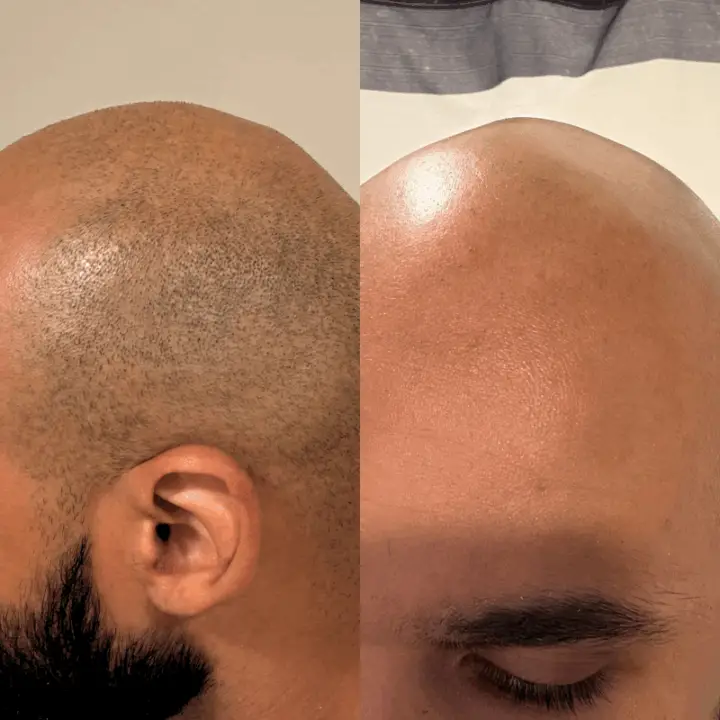
Shaving your head should be simple, repeatable, and kind to your skin. This guide walks you through a clear routine that helps you get a smooth dome with fewer ingrown hairs, less razor burn, and a controlled, matte finish.
We start with the right prep: a quick cleanse to lift oil and dead skin, plus light exfoliation a few times per week to improve razor glide. Then we dial in technique, mapping the grain, using short strokes with gentle pressure, and knowing when one pass is enough. After the shave, we cool the skin, calm it with alcohol-free care, rehydrate with a lightweight moisturizer, and finish with daily SPF.
New to the process?
Review the bald head care basics, then follow the step-by-step below.
Quick Takeaways for head shaving bald head
Cleanse, exfoliate, prep with shaving gel or shaving cream, shave, calm, moisturize, and apply SPF. Start in a warm shower or with a warm towel to soften stubble. Use a safety razor for precision or electric shavers for speed, keep blades fresh, use a handheld mirror to see the back. Shave with the grain first using short strokes and light pressure, reapply gel if areas dry out, rinse the blade often. Cool rinse after, use alcohol free post shave, then a light moisturizer for a controlled matte finish. Wet shaving your head requires some unique techniques to get the best results.
What You’ll Need
A smooth shave starts with the right kit. Keep a gentle cleanser on hand to wash away oil and buildup before you begin.

Add an exfoliating product to your routine a few times a week, such as a gentle scalp scrub to remove dead skin cells and help prevent clogged pores.
For glide, use a quality shaving gel or cream, and consider a few drops of shave oil if your skin is especially dry. Always work with fresh blades to cut cleanly and reduce irritation.
After the shave, calm the skin with an alcohol free toner, follow up with a light mattifying moisturizer, and seal everything in with daily SPF 30 or higher.
Step-By-Step Routine

1) Cleanse
Start with warm water to soften the scalp and open pores. A gentle cleanser clears away oil, sweat, and dead skin so your razor can glide without resistance.
Take about thirty seconds to work it in with small circular motions, paying attention to the crown and neckline where buildup is common.
If you are prone to bumps or ingrown hairs, a cleanser with a small amount of salicylic acid can help keep follicles clear. Rinse thoroughly to avoid residue, then pat your head lightly with a towel.
A clean surface is the foundation of a comfortable shave and keeps your blades from dulling too quickly.
2) Exfoliate
Exfoliation is a simple step that makes a noticeable difference. Two to three times per week, use short, gentle passes with your fingertips or a soft brush to lift away loosened dead skin cells. This not only smooths the surface but also helps prevent clogged pores and reduces the risk of ingrown hairs.
For an easy upgrade, work in a scalp scrub that combines mild grit with nourishing ingredients.
The goal is to encourage circulation and prep the scalp for better razor glide, not to scrub harshly. Keep it light, and always skip this step if your scalp feels irritated from a recent shave.
3) Prep & Glide
Once the scalp is clean and damp, apply a thin layer of shaving gel or cream.
The slicker the surface, the easier the razor will glide and the less chance of tugging or irritation.
If your skin runs dry, add a few drops of shave oil under the gel for extra cushion. Always work with a sharp blade, and replace it when it feels dull. Dull blades pull on stubble and increase the risk of nicks.
As you move through the shave, rinse your razor frequently to clear away stubble and built up shaving gel. Consistent prep makes the shave smoother and cuts down on repeat passes.
4) Shave: With The Grain First
Shaving with the grain, meaning in the same direction your hair grows, sets the stage for comfort.
Use light, even pressure and short, smooth strokes. Start at the top and work methodically toward the back, checking a handheld mirror to stay consistent. Resist the urge to press harder, since that leads to irritation.
For many men, one with-the-grain pass is enough for a clean look. If you want a closer finish and your skin can handle it, add a second pass across the grain only. Always reapply shaving gel on areas that start to dry.
If you are just learning the technique, take time to learn the basics of how to shave your head for extra guidance, especially if you’re balding.
5) Rinse, Cool, Soothe & Moisturize
After shaving, splash your scalp with cool water to calm the skin and close down pores. Pat dry gently instead of rubbing. Apply a soothing product like alcohol free witch hazel or pure aloe to reduce redness. Once absorbed, lock in hydration with a lightweight mattifying moisturizer. This step prevents dryness, leaves the scalp smooth, and controls excess shine throughout the day. To build a complete routine, you can explore a full line of bald head care products. For specific hydration options, compare picks for the best bald head moisturizer guide to find the right finish for your skin type.
6) Daily Protection
The scalp is fully exposed to the sun, which makes SPF non-negotiable. Use a broad-spectrum sunscreen of at least SPF 30 every morning, even if you are not planning on being outside long. Choose a lightweight formula that will not leave heavy residue or add unnecessary shine. Mineral-based sunscreens with zinc oxide or titanium dioxide work well for sensitive skin. Reapply every two hours if you are outdoors, especially during summer months, to avoid scalp sunburns and long-term damage. Making sunscreen a daily habit is the final step in keeping your shaved head healthy, smooth, and photo ready.
Electric vs. Razor
Both electric shavers and safety razors can give you a clean, bald head, but the best choice depends on your skin type, hair texture, and routine.
Electric shavers are quick, convenient, and often gentler on sensitive skin. They are ideal if you shave often, prefer a low-maintenance approach, or want to reduce the chance of nicks. Use light, consistent pressure, and move in small circles with rotary heads or straight strokes with foil shavers.
Safety razors, on the other hand, deliver the closest shave and a very smooth finish. They suit men with coarser hair or those who value precision.
The technique requires patience: hold the razor at about a 30 degree angle and let the blade do the work without pressing.
No matter which you use, rinse thoroughly after each shave, dry completely, and replace blades regularly to maintain comfort and hygiene.
Troubleshooting & Maintenance
Even with a solid routine, issues can pop up from time to time. Razor burn is a common problem that usually results from too much friction.
To fix it, focus on more glide by using a generous amount of shaving gel, limit yourself to fewer passes, and finish with cooler water to calm irritation.
Ingrown hairs are another frequent complaint. The simplest solution is to commit to shaving strictly with the grain for at least a week to allow follicles to reset.
Adding a gentle salicylic acid pad two or three times per week can also help keep pores clear and prevent hair from curling back into the skin. If your scalp feels dry or itchy, apply moisturizer consistently after every shave and avoid products with heavy fragrance that can cause extra irritation.
Finally, do not forget blade care. Rinse your razor thoroughly during and after each shave, pat it dry, and replace blades before the metal begins to corrode. Good maintenance not only improves comfort but also extends the life of your shaving tools.
FAQs
How to take care of a bald head after shaving?
After shaving, rinse your scalp with cool water to calm the skin. Pat it dry gently and apply an alcohol free toner such as witch hazel or aloe to reduce redness. Follow with a lightweight moisturizer to prevent dryness and finish with SPF 30 or higher if you are heading outdoors. This sequence keeps your scalp smooth, comfortable, and protected.
How often should I shave my head?
Most bald men find that shaving every one to three days maintains a clean look without irritation. If your hair grows fast and you like a perfectly smooth finish, a daily shave may suit you. If you have sensitive skin or deal with razor burn, spacing out shaves to every other day or longer can help keep your scalp healthy.
Should I wash my scalp before shaving?
Yes, washing your scalp before shaving is essential. A gentle cleanser removes oil, sweat, and debris that would otherwise clog your razor and increase the risk of irritation. Warm water also softens stubble, making it easier for the blade to glide. A clean surface reduces friction, helps prevent bumps, and gives you a smoother result.
Should I moisturize after shaving?
Always moisturize after shaving to restore hydration and protect your scalp. Shaving removes natural oils along with stubble, which can leave skin feeling dry or tight. A light, fast-absorbing moisturizer prevents flaking and keeps your scalp looking healthy. For a polished finish, choose a mattifying option that reduces shine without leaving residue.
About The Author: Abel Disla is the founder of Domepeace, a premium scalp care brand helping bald men embrace confidence and Gold standard grooming.
